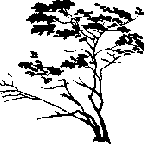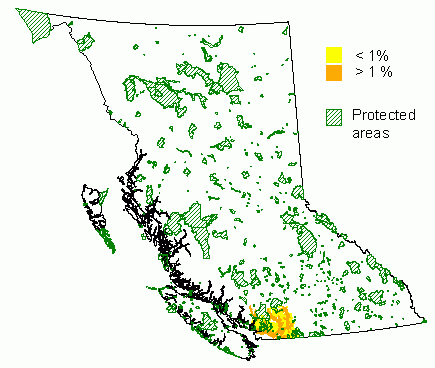 Vine maple
Vine maple
Acer circinatum Pursh
Introduction
Vine maple is a long-lived, deciduous shrub or small tree. It commonly occurs along rivers, in forest openings and on recently logged areas. Since it sprouts, it may re-grow in clumps or patches after top damage. Vine maple is a shade-tolerant shrub found in the understory of both early and late successional forest stands. Its foliage is a preferred food of deer and elk, and numerous birds and small mammals feed on the seeds, buds, and flowers. Vine maple is used as an ornamental tree because of its beautiful autumn leaf colours (Uchytil 1989). The first peoples used its hard wood to make a variety of utensils (Turner 1979).
Vine maple occurs throughout the Pacific Northwest. Its range stretches from southwestern British Columbia to northern California along the coast, including Vancouver Island (Little 1976). The area in British Columbia represents less than half of its total range.
Distribution and Protected Areas – from Hamann et.al. 2005



Conservation Status Summary – from Chourmouzis et.al.
No in situ conservation concerns were identified for this species.
Reproduction
Seed crops are annual but irregular (Banerjee et al. 2001). Vine maple produces few seeds and relies primarily on vegetative reproduction by sprouting or layering (Anderson 1969; O’Dea 1995). Plants reproduce from the base of the stem after logging or fire. Occurrence of vine maple in early successional communities is therefore primarily dependent upon its predisturbance distribution (Hubbard 1950). This would imply that the species’ genetic diversity is not usually affected by one cycle of logging. However, Tappeiner and Zasada (1993) reported good seedling emergence for vine maple, especially in thinned stands, implying that under the right light conditions, sexual regeneration does take place.
Genetic structure
No information available.
Resource management and seed transfer
No information available.
REFERENCES
Hamann, A., Smets, P., Aitken, S. N. and Yanchuk, A. D. 2005. An ecogeographic framework for in situ conservation of forest trees in British Columbia. Can. J. For. Res. 35:2553-2561. View online resources for this report.
C. Chourmouzis, A.D. Yanchuk, A. Hamann, P. Smets, and S.N. Aitken. 2009. Forest Tree Genetic Conservation Status Report 1: In situ conservation status of all indigenous BC species. Centre for Forest Conservation Genetics, Forest Genetics Council of BC, and BC Ministry of Forests and Range, Forest Science Program, Victoria, BC Technical Report 053. www.for.gov.bc.ca/hfd/pubs/Docs/Tr/Tr053.htm
Anderson, H. G. 1969. Growth form and distribution of vine maple (Acer circinatum) on Marys Peak, western Oregon. Ecology 50:127-130.
Banerjee, S. M., Creasy, K. and Gertzen, D. D. 2001. Native woody plant seed collection guide for British Columbia. Crown Publications, Victoria. 147 p.
Hubbard, W. A. 1950. The climate, soils, and soil-plant relationships of an area in southwestern Saskatchewan. Scientific Agriculture 30:327-342.
Little, E. L., Jr. 1976. Atlas of United States trees, volume 3, minor western hardwoods. U.S. Department of Agriculture Miscellaneous Publication 1314. 13 p., 290 maps.
O’Dea, M. E., Zasada, J. C., Tappeiner, J. C. 1995. Vine maple clone growth and reproduction in managed and unmanaged coastal Oregon Douglas-fir Forests. Ecological Applications 5:63-73.
Tappeiner, J. C. and Zasada, J. C. 1993. Establishment of salmonberry, salal, vine maple, and bigleaf maple seedlings in the coastal forests of Oregon. Canadian Journal of Forest Research 23:1775-1780.
Turner, N. J. 1979. Plants in British Columbia Indian technology. B.C. Provincial Museum Handbook no. 38. BC Provincial Museum, Victoria, B.C. 304 p.
Uchytil, R. J. 1989. Acer circinatum. U.S. Department of Agriculture, Forest Service, Rocky Mountain Research Station, Fire Sciences Laboratory (2002, January). Fire Effects Information System. [Online]. Available: http://www.fs.fed.us/database/feis/ [January 2002].
